This is not your father's retic
In the last 20 years, there has been an evolution in the captive reticulated python (Python reticulatus reticulatus), certainly in the public perception, and in a physical sense, as well. Until the early 1990s, most reticulated pythons available to the public were captured in the wild, most likely in Thailand, at a size somewhat larger than babies. They were held in a dealer’s compound, exported to a dealer on the other side of the world, transported to a pet shop and eventually found their way to a keeper. The snake was dropped into a cage that the snake probably didn’t find quite satisfactory as its new owner exclaimed, “This thing is mean!”
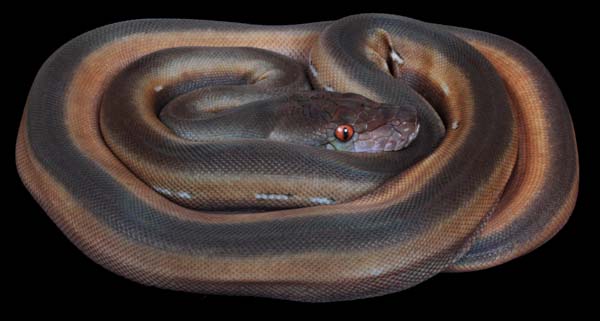
Photo by Bob Clark
Titanium retic morph.
Much has changed in the last two decades. Reticulated pythons are much more widely available. Nearly all are now born in captivity, and many do not resemble their wild relatives in the slightest. The range of available colors, patterns and sizes is nearly overwhelming. These days, I rarely hear a complaint about the species’ temperament. Public perception of retics has improved dramatically, and the number of keepers and breeders has increased exponentially.
Physically, retics are similar to other commonly kept python species, but younger animals are more slender than ball, Burmese or blood pythons. As reticulated pythons grow, they become proportionally more heavy bodied. The name “reticulated” means net-like, and it refers to the snake’s pattern of irregular, geometric markings on a contrasting background. The pattern and coloration has evolved, as it has in many animals, to allow them to be less conspicuous to potential predators and prey alike. Most deviations from this make it less likely that the animal will survive to adult, breeding age and size. More on this later.
The reticulated python has the largest natural range of any python species, living in a variety of habitats throughout southeast Asia. It is the largest species of snake and reaches exceptional sizes more consistently than other snake species. Specimens are remarkably similar across a huge geographic area, with a few notable exceptions in size and pattern. Three subspecies have been described to date, and I’m certain, as the species receives more attention, more geographic variants will be named (for more information, go to www.ncbi.nlm.nih.gov/pubmed/12135085).
Reticulated Python Captive Care
My experience with reticulated pythons has been with captive animals. I’ve kept retics for more than 40 years and have bred them for nearly 30. They make excellent captives and continue to gain popularity. They are undemanding, with requirements similar to most other pythons.
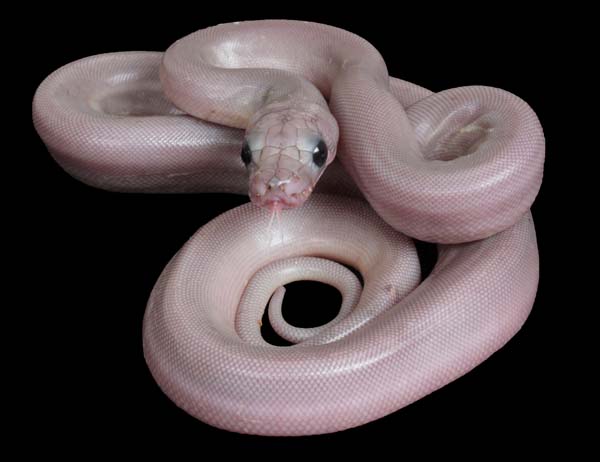
Photo by Bob Clark
There is a tendency to want to provide the snake with the largest enclosure that space and resources will allow. Most retics, however, prefer something a little less spacious.
First, the enclosure itself. The cage serves two purposes: one, to keep the snake in, and two, to maintain an environment favorable to the snake’s health and well-being. I favor enclosures made of plastic, but wood and glass are both viable alternatives. In the snake rooms at my facility, hatching retics begin their lives in plastic tubs, measuring 20 inches long, 14 inches wide and 6 inches tall, held in large racks. Larger animals are housed in proportionately larger cages. Most adult snakes can be comfortably housed in enclosures measuring 72 inches long, 32 inches wide and 28 inches tall. There is a tendency to want to provide the snake with the largest enclosure that space and resources will allow. Most retics, however, prefer something a little less spacious. Small snakes in large cages often feel exposed and insecure, and this can lead to problems with feeding and aggression. For the most part, retics are terrestrial and space on the horizontal plane is more important than that on the vertical.
Watch the Reticulated Python Quick Care Video
Wild retics live in areas of warm temperatures and high humidity. Given that the snake requires conditions that differ from those in which snakekeepers are comfortable, you’ll need to make sure the cage can generate and maintain these conditions. I like to provide a temperature gradient from 80 degrees Fahrenheit on one end of the cage to 90 degrees on the other. This allows the snake to choose the temperature that it prefers. The cage will require a supplemental source of heat to achieve this. I prefer heat tape or a heat pad under one end of the cage. Placing the heat source on one end of the enclosure will allow for the maximum heat gradient and a wider range of temperature choices for your snake.
Cage humidity is not so much generated as it is conserved. Cage joints and edges should be sealed, and wood surfaces should be painted. Little ventilation is needed by the snake, so screen tops and large vents should be avoided. Any vents should be placed on the side of the cage rather than the top; otherwise, heat added to the cage by the heat source will rise and escape through top-mounted vents, requiring more heat to be added and moisture to be lost.
I use newspaper for a substrate. It’s absorbent, relatively sterile, cheap and readily available. Various wood products are also acceptable. Cypress mulch resists decay and holds moisture well. Shredded aspen has a more uniform appearance, at least when it’s new and clean. There is a balance between aesthetics and utility. Newspaper isn’t the most visually attractive, but it’s easy to clean and does the job.
Reticulated Python Feeding Versus Size
Some reticulated pythons can get very large. As with any captive animal, they should be kept only by people who are prepared to provide for their needs and keep them for the long haul. That said, I’m sure there’s a retic that your grandmother can keep in her apartment.
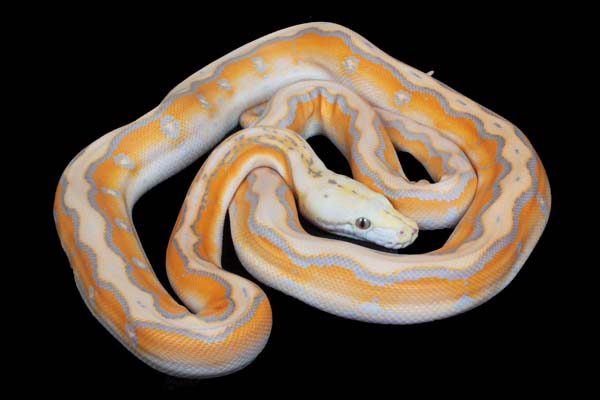
Photo by Bob Clark
Purple Motley retic morph.
Retics are capable of tremendously rapid growth. They are designed to utilize food resources while they are available. They are also capable of subsisting on almost nothing until food is available again. For wild snakes, food availability can be a matter of luck, seasonality or other factors. The snakes are programmed physiologically to deal with both abundance and scarcity.
Regular weekly feedings, access to clean fresh water, lack of predators, parasites and perfect weather—believe me, your snake thinks your basement or extra bedroom is the promised land! Life in the wild is very different, yet snakes have evolved to thrive there. There is a level of food intake that is necessary for the animals to maintain function and health. Everything in excess of this can be available to allow growth. Snakes are not like mammals that grow and mature along a predetermined course. Sexual maturity is determined to a large extent by size. Depending on the availability of food, maturity may be attained quickly, slowly or maybe not at all.
You control your reticulated python’s food resource. As a result, you have control of your snake’s rate of growth and ultimate size. I have few males in my facility more than 10 feet long, about 20 pounds. A male this size can breed and do everything that is expected of him. On the other hand, I have many very big females. Big females lay more eggs. I allocate more of my food resources to the females. I’m in the snake-breeding business. I want my females to be as productive as possible. You control of your snake’s growth! I often hear people say, “Retics get too big!” Well, whose fault is that? I feed young animals appropriately sized rodents weekly. Adults are fed larger meals less frequently. Breeding animals may not feed at all for several months of the year.
That said, not all retics have the potential to attain a large size. Recently, several dwarf types of reticulated pythons have become available. These are geographic variants, subspecies both named and unnamed that lack the potential to achieve a large size. I’ve bred one female each of the last three years that is 5½ feet long and weighs only 3 pounds—that’s not much bigger than a large corn snake!
Are Reticulated Pythons Aggressive?
We’ve all heard it: Retics are mean! About 25 years ago, when all reticulated pythons came to us right out of the jungle, that may have been true. I don’t claim to be the Snake Whisperer, but I do know something about snake behavior. A snake’s response to fear, to insecurity and to stress can be aggression. If the snake doesn’t feel safe in its environment, it views you as a threat and it will do all it can to get you to leave it alone. In the wild, it can turn tail and run, but in its cage, all it can do is try to bite or at least act like it’s going to bite you. A snake’s just got a little snake brain. If a big animal catches it and picks it up, what’s it to think? I’m dinner! That’s always a fear generator!
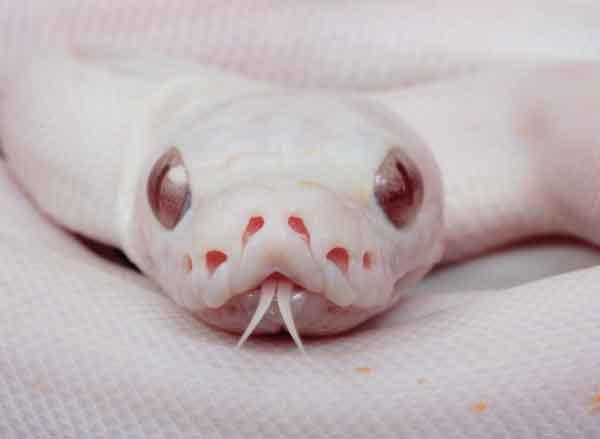
Photo by Bob Clark
We’ve all heard it: Retics are mean! About 25 years ago, when all reticulated pythons came to us right out of the jungle, that may have been true. Albino Super Motley Fire.
Captive-born snakes have less stress from adapting to a new environment. If they can “know” anything, they do come to realize that the person who feeds them never hurts them. In fact, nothing bad ever happens. No fear, no stress, no aggression. Burmese pythons and reticulated pythons have similar temperaments. We’ve just been keeping and breeding Burmese pythons longer. Eventually, I’ll convince everyone of this!
Are Reticulated Pythons Smart?
I often hear people say that reticulated pythons are smarter than other snakes and credit some of their appeal to this perceived intelligence. I’m not sure how they’ve determined this, and I question the assertion. I will say that reticulated pythons are probably more active than many other species of pythons and might go so far as to say they seem to be more aware of their environment and what’s going on around them.
Reticulated Python Breeding
Two things that make a snake popular are ease of breeding and the availability of a variety of color and pattern variations. Retics have both. I’ve hatched reticulated pythons in every month of the year. They seem to be slightly less seasonal than other python species. Nevertheless, most breeding activity occurs during the fall and winter, and eggs are laid in late winter and spring. In captivity, most python and boa species respond well to a period of slightly cooler nights in the fall and start breeding at this time. I do not make an effort to encourage breeding in my retics by manipulating temperatures as I do with other species. That said, there are likely subtle seasonal changes inside my retic building that may trigger breeding activity.
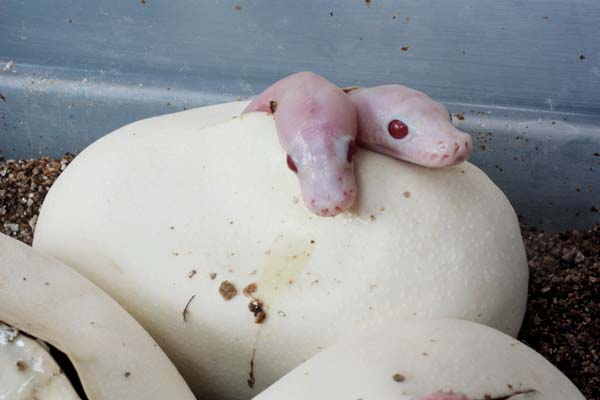
Photo by Bob Clark
Albino Super Motley Fire twins hatch from their egg.
At my facility, most eggs are laid in February, March and April. Incubation is longer than other python species and averages about 84 days. Eggs hatch equally well when incubated maternally or artificially in an incubator. Female pythons lay their eggs in a compact pile. The eggs adhere to one another and are protected within the mother’s tight coils. Even though pythons and other reptiles are cold blooded, some python species, reticulated pythons included, have the ability to generate heat in order to incubate eggs at the proper temperature.
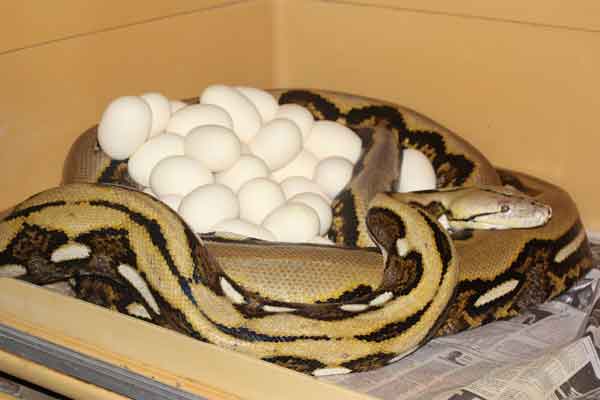
Photo by Bob Clark
Eggs can be hatched naturally. The female curls around her eggs and provides them the warmth and humidity they need within her coils.
The mother’s body acts as an effective barrier between the environment she’s created inside her coils and that on the outside. Her coils also maintain the proper humidity required for successful incubation. While her body does not generate moisture as it does heat, it does conserve the moisture produced by egg respiration and allows it to escape if necessary, as well. In the incubator, I hatch retic eggs (and all python eggs) at 90 degrees Fahrenheit, a temperature that is comparable to what the mother provides when she has the responsibility of incubation.
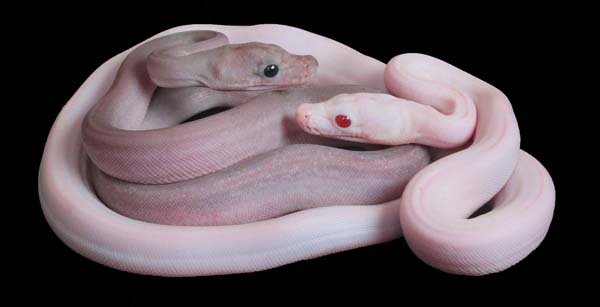
Photo by Bob Clark
Super Motley Fire and an Albino Super Motley Fire.
In 1992, my friend, Karl Hermann, then of St. Paul, Minn., bred a strangely patterned reticulated python to a normal-looking female. Half of the resulting offspring resembled their father. These were the first captive-born retics to show a different pattern than their wild cousins and the first co-dominant mutation known to herpetoculture. In 1999, I introduced the first albino retics, and later, sunfire, genetic stripe, another albino type and blond. I’m especially proud of my two most recent morphs: motley and pied. These color and pattern mutations, along with others, including some notable morphs from New England Reptile Distributors and Prehistoric Pets, have fueled exponential growth in the number and variety of captive-produced reticulated pythons. The combinations of these traits with each other, and with the dwarf and super dwarf forms, provide today’s retic keeper with choices we could never have imagined a few years ago.
Reticulated Python Morphs
In the late summer of 2006, I hatched a strange-looking male albino retic after breeding an albino male to a heterozygous female. The snake was an albino with intense orange, nearly patternless sides and two wavy parallel dorsal stripes. I assumed at the time that this snake, while much different in appearance than other albinos, was a non-genetic aberration. I kept him as an interesting and attractive oddity. Once he reached sexual maturity, I bred him back to his mother and produced both albinos and normally colored snakes with the same pattern and appearance. I named the trait “motley.” I assumed, at the time, that the trait was recessive and that the female was also a carrier of the trait. The following year, I bred him to several females, and all produced motley babies!
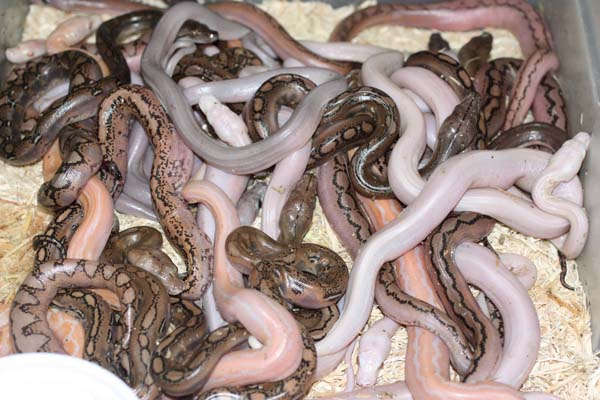
Photo by Bob Clark
The variety of colors and patterns available has grown extensively over the last 20 years.
A pattern mutation had occurred spontaneously from normal animals at my facility. Genetic mutations, at least those that affect the appearance, are exceedingly rare. Most occur in the wild, not captivity, for a simple reason. It’s an odds game. There are many more animals there! Pattern and color in an animal evolve in a way that increases its fitness, its ability to survive and reproduce. Random genetic mutations are the basis for this evolution. Animals with changes that help them survive slightly better are more likely to reproduce and pass these traits to their offspring. Albinism is a death sentence for a wild animal. Oddly colored animals may find it more difficult to hide from predators, their prey and the catchers that bring these animals to breeders like me!
Animals showing the motley trait, when bred, produced offspring that also exhibited the trait. Unlike the various forms of albinism, the striped trait and many other traits that influence color and pattern, the motley mutation is expressed in the heterozygous form. Once this was determined, the next question on everyone’s mind was: What will the homozygous condition look like? Would there be a super form? If a baby snake received a copy of the motley gene from each parent, would it have a different appearance? I’d been raising a small group of female motleys to help answer that last question, but on Memorial Day weekend, 2011, my facility suffered a serious fire, and these animals did not survive. I started raising some new animals, and they reached maturity and bred for the first time this year.
Want to Learn More?
Reticulated Python Species Profile
Reticulated Python From Kansas City, MO Is World's Longest Snake
I paired a male fire motley heterozygous for albino with a female albino motley this season. The young female laid a beautiful clutch of eggs. As they started hatching I found the expected assortment of fires, motleys, fire motleys, albinos, etc. I inspected each one for some difference, however slight, that might give indication of the homozygous (super) motley. I peeked inside each egg with more hope than real expectation that I might find something wonderful inside. I was not disappointed. One of the last eggs contained a pure-white snake with blazing red eyes! Obviously, this snake was an albino, but it was also patternless. The albino trait had taken away the color, but apparently, the double dose of the motley trait had taken the pattern. There was no differentiation between pupil and iris—it was a solid red eye.
The second breeding produced albino super motleys, as well, but also two animals without the albino trait. They were patternless, as expected, but exhibited an extraordinary purplish-silver coloration with solid black eyes. Spectacular animals!
The winter of 2006 was very good for me. I was fortunate to acquire an unusual adult male reticulated python recently captured in Indonesia. The snake was steel blue gray, nearly patternless, with a bright white belly. This white color extended up the sides to varying degrees along the entire length of the snake. With a little generosity, hope and wishful thinking, we called the snake “pied.” If I squinted my eyes a little, I could almost see that snake as the retic equivalent of a low-expression pied ball python.
The snake would not feed at first but was eventually convinced to accept dead quail. The following season the snake bred and produced normal-looking offspring. Females from this breeding were raised to maturity and bred to the original wild male. In early 2011 eggs were laid, and in May of that year, early one morning, I opened the incubator to see one of the eggs showing a small lengthwise cut. With much anticipation and excitement, I enlarged this opening just enough to see a section of baby snake showing two large white areas separated by a pigmented spot. Better than I imagined it could be! New projects can take a long time to bear fruit. They often involve a considerable investment in time, effort and resources. It’s difficult to convey the gratification, the satisfaction and the emotion of that moment. At 6 a.m. that spring morning, I lifted my voice in joyous song, did the Happy Snake Dance, then sat at my desk and wept (which cannot be independently confirmed, and henceforth, I will deny it). This season, I’ve produced the albino version of the pied, and I’m currently working on combining this fantastic trait with existing morphs.
The increasing interest in the reticulated python has been fueled by an ever-growing number of morphs and morph combinations. More keepers are becoming breeders and the availability of high-quality animals in a multitude of colors, patterns and sizes is at an all-time high. There’s a retic for every taste!
Bob Clark earned his BS in biology from the University of Kansas in 1977 and his MA in herpetology from the same university in 1979. Bob has bred pythons for 40 years. Under the banner of Clark, Inc., incorporated since 1988, he is involved full time in the commercial production of pythons for keepers, breeders and exhibitions. Visit him at bobclark.com and facebook.com/bobclarkreptiles.


